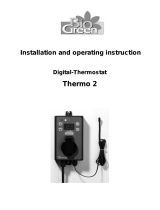
3
English
Safety Information
WARNING
• Hazards or unsafe practices that may result in severe
personal injury or death.
CAUTION
• Hazards or unsafe practices that may result in minor
personal injury or property damage.
• Carefully follow the precautions listed below because
they are essential to guarantee the safety of the
equipment.
WARNING
• Always disconnect the air conditioner from the power
supply before servicing it or accessing its internal
components.
• Verify that installation and testing operations are
performed by qualified personnel.
• Verify that the air conditioner is not installed in an
easily accessible area.
General information
WARNING
• Carefully read the content of this manual before installing
the air conditioner and store the manual in a safe place in
order to be able to use it as reference after installation.
• For maximum safety, installers should always carefully
read the following warnings.
• Store the operation and installation manual in a safe
location and remember to hand it over to the new owner if
the air conditioner is sold or transferred.
• This manual explains how to install an indoor unit with a
split system with two SAMSUNG units. The use of other
types of units with different control systems may damage
the units and invalidate the warranty. The manufacturer
shall not be responsible for damages arising from the use
of non compliant units.
• The manufacturer shall not be responsible for damage
originating from unauthorized changes or the improper
connection of electric and requirements set forth in the
“Operating limits” table, included in the manual, shall
immediately invalidate the warranty.
• The air conditioner should be used only for the
applications for which it has been designed: the indoor
unit is not suitable to be installed in areas used for
laundry.
• Do not use the units if damaged. If problems occur, switch
the unit off and disconnect it from the power supply.
• In order to prevent electric shocks, fires or injuries, always
stop the unit, disable the protection switch and contact
SAMSUNG’s technical support if the unit produces smoke,
if the power cable is hot or damaged or if the unit is very
noisy.
• Always remember to inspect the unit, electric connections,
refrigerant tubes and protections regularly. These
operations should be performed by qualified personnel
only.
• The unit contains moving parts, which should always be
kept out of the reach of children.
• Do not attempt to repair, move, alter or reinstall the unit.
If performed by unauthorized personnel, these operations
may cause electric shocks or fires.
• Do not place containers with liquids or other objects on
the unit.
• All the materials used for the manufacture and packaging
of the air conditioner are recyclable.
• The packing material and exhaust batteries of the remote
controller(optional) must be disposed of in accordance
with current laws.
• The air conditioner contains a refrigerant that has to be
disposed of as special waste. At the end of its life cycle,
the air conditioner must be disposed of in authorised
centres or returned to the retailer so that it can be
disposed of correctly and safely.
Installing the unit
WARNING
IMPORTANT: When installing the unit, always remember to
connect first the refrigerant tubes, then the electrical lines.
• Always disassemble the electric lines before the
refrigerant tubes.
• Upon receipt, inspect the product to verify that it has not
been damaged during transport. If the product appears
damaged, DO NOT INSTALL it and immediately report
the damage to the carrier or retailer (if the installer or the
authorized technician has collected the material from the
retailer.)
Safety Information






















